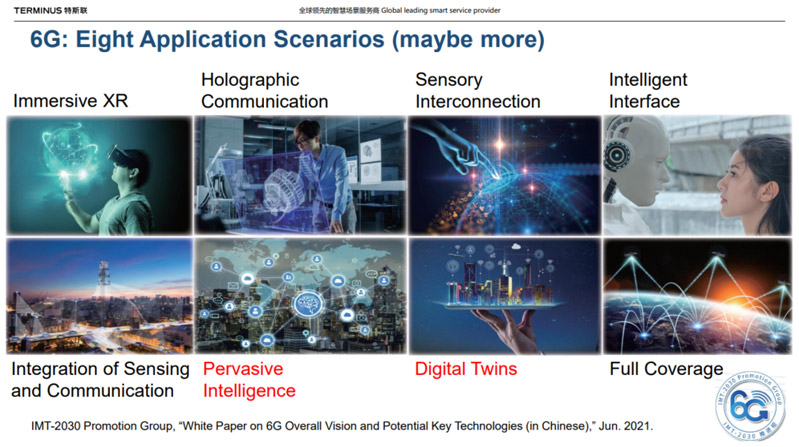Terminus Group presents outlook for 6G and user-centric AIoT technology for optimal business customization and development
The second nGRG workshop, held alongside the ongoing O-RAN ALLIANCE F2F meetings, was recently held in Prague, which is a key event for the academic community's representatives to meet and discuss from various fields discussed the key issues that face open RAN in 6G.
Attending the workshop, Dr. Yang Yang, the Chief Scientist of the global smart services company, Terminus Group, discussed the various aspects of the company's strategy and outlook for the future of 6G. He noted that the rapid emergence and evolution of new intelligent services will require the creation of a comprehensive and personalized experience for users.
.jpg)
(Dr. Yang Yang, Chief Scientist of Terminus Group)
Presenting his views on the topic of Network AI: Enabling 6G Pervasive Intelligence, Dr. Yang discussed the various factors that will influence the development of this technology and its evolution. According to him, the main factors that will contribute to the evolution of this technology are the availability of high-quality network services, flexibility of resource management, reliable network services, and integrated service architecture.
The concept of the supply-side model is also contributing to the development of next generation mobile communication systems. Through the various application scenarios that have been set across 3G, 4G, and 5G mobile communication systems, it continues to improve its performance index and increase its efficiency. For instance, the multiple features of 5G, such as the enhanced Mobile broadband (eMBB), massive Machine Type Communications (mMTC), and Ultra Reliable Low Latency Communications (URLLC), each have a significant impact on the performance of the network.
In a white paper released by the IMT-2030 Promotion Group, it stated that 6G business will comprise of eight applications. These include immersive cloud XR, holographic communication, sensory interconnection, intelligent interface, integration of sensing and communication, pervasive intelligence, digital twins, and full coverage.

According to Dr. Yang, the development of 6G will allow cities to benefit from the increasing digitalization and interconnection of 5G. It will also enable them to create a personalized and high-quality service experience for their users.
The realization of this vision is driven by a need to not only to improve the network KPIs in different application scenarios, but also to adopt the demand-side service traction mode and make rational use of heterogeneous network resources and universally smart nodes. In doing so, conduct real-time and effective analysis and integration of massive multidimensional information in the real and digital world to comprehensively address the personalized and customized needs of each user.
To this end, and as part of his presentation, Dr. Yang introduced a new 6G network architecture that will allow service providers to create a personalized and high-quality service experience for their users. He was joined by over 50 industry experts from various industry sectors, where he offered four key take-aways from his presentation.
1. The concept of the Service Requirement Zone (SRZ) was first introduced to help service providers identify the various requirements of their customers. This process can be carried out through the use of a variety of tools and techniques. The goal of the SRZ is to provide a comprehensive view of the multiple aspects of the user's end-to-end service experience.
2. In order to determine the 6G system's ability to deliver a high-quality service experience, we introduced the concept of the User Satisfaction Ratio (USR). This method is used to measure the overall satisfaction of users. It takes into account the various dimensions of the SRZ and then provides a final system performance report.
3. To achieve high-quality of experiences (QoE) and improve the USR of 6G users, Dr. Yang proposed a multi-level network architecture that consists of a multi-functional node (mNode) and an integrated heterogeneous system. This includes a smart localization AI service platform that can be used to address the specific needs of different users.
4. In order to evaluate the performance of the 6G network intelligent architecture, Dr. Yang has carried out a lot of experiments and simulations. Through these studies, the proposed intelligent network architecture can perform better than the cloud AI or edge AI architectures when it comes to achieving USR in different services tasks and network situations.
Taking VR/AR interactive games and mobile online banking as examples, different user needs are represented by different shapes of SRZ. The USR can be calculated from the support results of the 6G system for the multi-dimensional service requirements of SRZ, which reflects the overall service capability of the 6G system for the personalized service requirements of different users.
Commenting at the event, Dr. Yang said: "The 6G network architecture will be able to bridge the digital divide by enabling the development of intelligent devices and services that will benefit the elderly and vulnerable groups. Through the use of AIoT, we can promote these individuals can benefit from the increasing digital economy."
About O-RAN ALLIANCE
The O-RAN Alliance was established in February 2018. It has since become a global community of mobile network providers, vendors, academic institutions, and other industry players.
The O-RAN Alliance's mission is to transform the RAN industry by creating a more open, intelligent, and fully interoperability mobile network. Through its specifications, the RAN ecosystem can more effectively improve the user experience. Mobile networks that are based on O-RAN can also help improve the efficiency of the operations of mobile operators.
